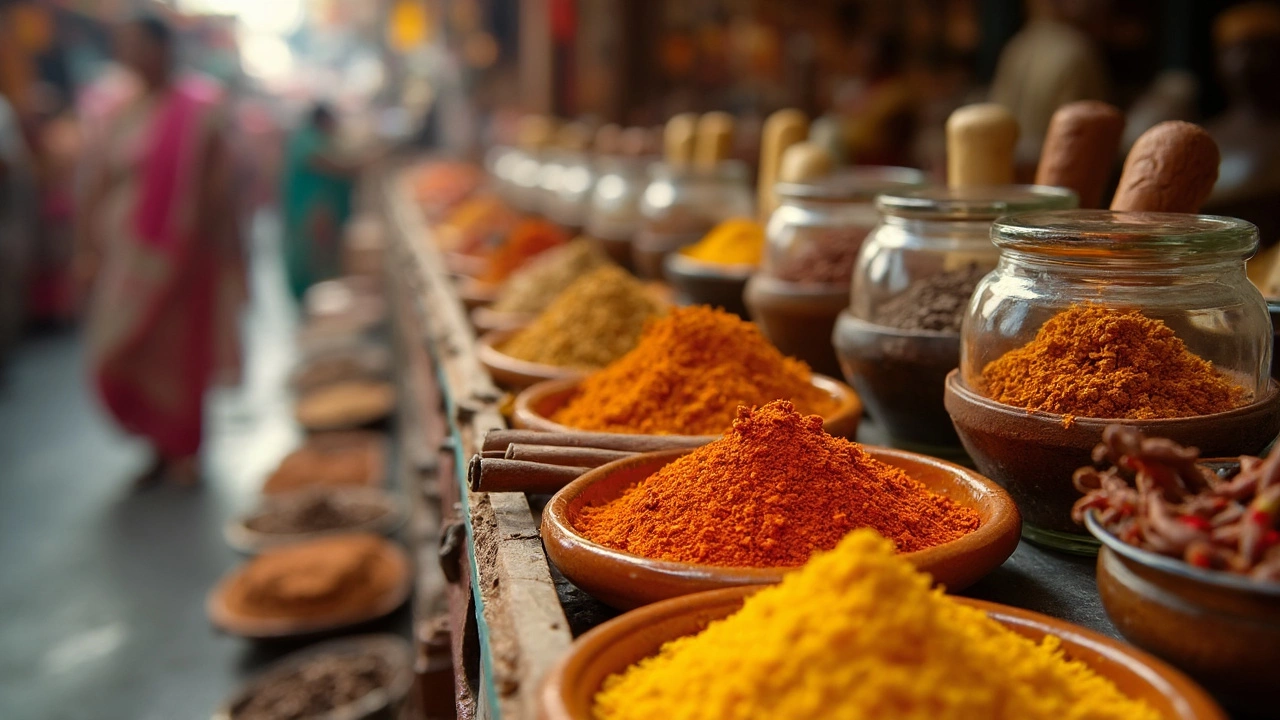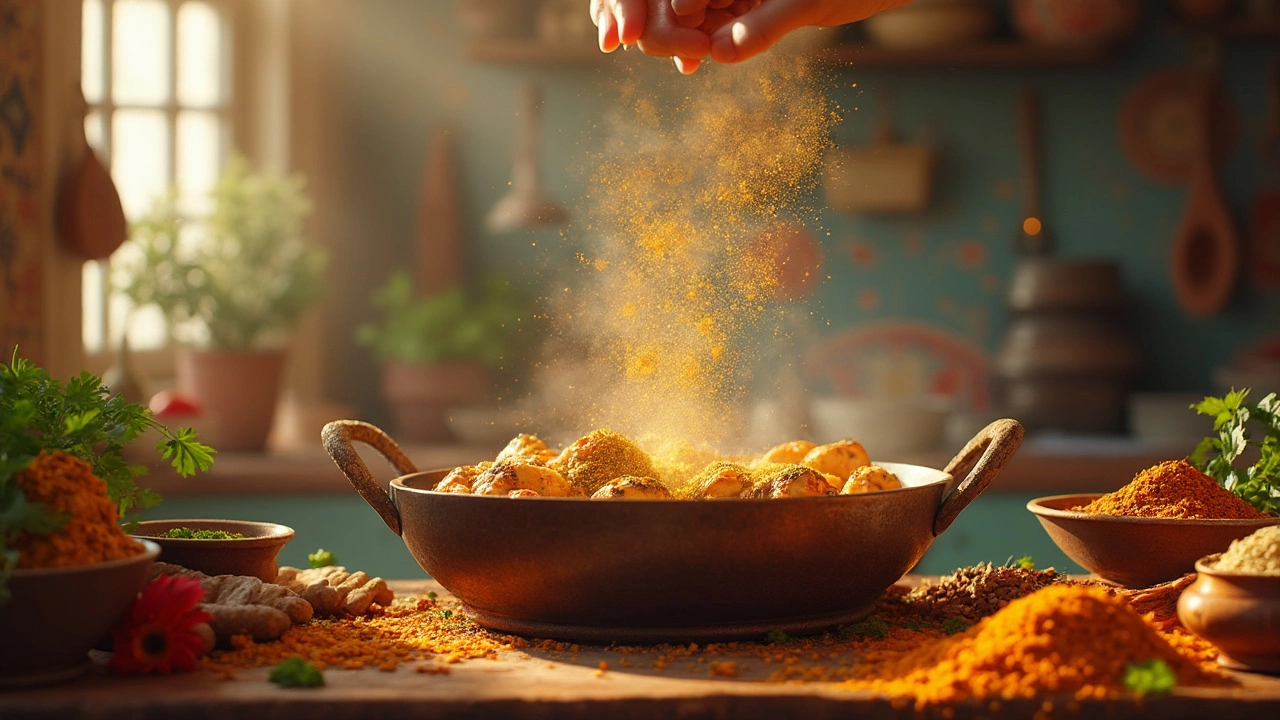So, you're ready to tackle making chicken curry, and you want it to taste just like that amazing dish from your favorite restaurant. The real question is, what is it that gives curry its unique kick?
Let's get straight to it. The secret lies in the spices. More precisely, turmeric is often hailed as the backbone of many curry dishes. Not only does it give curry that iconic yellow hue, but it also adds a warm, earthy flavor that ties everything together. Think of it as the glue that holds all those amazing tastes.
But there's more to the story! While turmeric may be a star player, it's the harmony of different spices that really makes a curry sing. You're probably familiar with a few, like cumin, coriander, and garam masala, each adding its own twist. Combined, they create a symphony of flavor that's irresistible.
We all know that a well-balanced curry can make your taste buds dance, while a poorly done one might just make you frown. But don't worry. Stick around, and we'll break down the tips and tricks to ensure your chicken curry is always a hit at the dinner table!
- The Heart of Curry: The Key Ingredient
- Why Spices Matter
- Balancing Flavors Like a Pro
- Quick Tips for Perfect Chicken Curry
- Common Mistakes to Avoid
The Heart of Curry: The Key Ingredient
What makes a curry what it is? It's the spices that whisk you away with their amazing aromas and flavors. But when you're talking about the heart of a curry, turmeric really stands out. This golden spice does more than just give that rich color; it adds a subtle flavor that's slightly peppery with a bit of mustard and earthiness mixed in.
This spice has been loved throughout history, especially in South Asian cooking. Turmeric not only gives tasty flavor, but it's also packed with health benefits. People often say it has anti-inflammatory properties, which is a win-win situation if you ask me!
While turmeric is a key player, don't forget about its buddies. Cumin and coriander do a lot of the heavy lifting, providing savory warmth and a hint of citrus, respectively. And we can’t overlook garam masala, that brilliant blend of spices like cinnamon, cardamom, and cloves, which give a sweet and spicy kick.
Making a curry without these spices is like baking a cake without sugar – sure, you might end up with something edible, but it won't have that signature taste everyone loves. So, when you’re planning your next cooking adventure, make sure your spice rack is stocked up with these essential ingredients.
Here's a quick tip: when shopping for spices, go for fresh and whole spices whenever possible. Whole spices maintain their oils and flavor better than ground ones. You can grind them at home using a coffee grinder or mortar and pestle.
So, remember, the secret to that killer chicken curry lies in these key spices. Once you master them, you're well on your way to making a dish that will keep everyone coming back for seconds.
Why Spices Matter
Ever wonder why one chicken curry can taste so different from another? It's all about those magical spices in your cupboard. Yes, each spice plays a unique role in creating that flavor explosion in your mouth. From adding heat to providing depth and aroma, every little pinch counts.
Take cumin, for instance. It's one of those unsung heroes that adds a nutty, warm undertone. And coriander? It provides a slight citrus note, breaking through the richness of the dish. Together, these two are often the backbone of many curry powders.
- Turmeric: Gives color and a slight bitterness
- Garam Masala: A mix that heightens warmth and aroma
- Cardamom: Offers a sweet and spicy kick
- Chili Powder: Adds the desired level of heat
Each of these spices contributes its own story to a dish. You could think of them as the characters in a drama, each with its own personality but working together to make the plot sing.
Imagine cooking your chicken curry and realizing it's a bit bland. Adding the right amount of garam masala at the end can make a world of difference. It's the grand finale of spice blends, tying all the flavors into one delicious bow.
While putting together your own mix might seem intimidating, it’s pretty straightforward once you get the hang of it. Start by experimenting with a basic mix and adjusting as you go. Remember, curry is like a playground for your chicken curry recipe—don’t be afraid to get creative.
So, the next time you're prepping your curry, take a moment to appreciate those jars of spices lined up. They're not just spices; they're the soul of your cooking.

Balancing Flavors Like a Pro
Creating the perfect chicken curry is like painting a masterpiece on a clean canvas. You need just the right touch of flavors to make it stand out. Here’s how you can make sure you're nailing the balance like a seasoned chef.
First and foremost, it’s all about the spice. But wait, before you dump in a whole jar of anything, remember: quality over quantity. Spices like turmeric, cumin, and coriander are crucial, but it's all about getting the mix just right. Start small and build up.
Think of salt and sugar as your trusty sidekicks. Salt isn’t just for seasoning, it actually helps bring out the other flavors, while a tiny bit of sugar (think a teaspoon) can neutralize any bitterness and enhance the savory elements.
- Start with a base of onions and garlic; it's hard to go wrong with these. Sauté them until they're golden.
- Introduce your spices gradually—toast them slightly to release those magic aromas.
- Add in chicken, but don’t rush. Let the meat absorb all those lovely spices.
Now, here's a pro tip: always taste as you go! It's the best way to make sure you're not overpowering one spice over the others. And don’t forget to simmer; allow everything to melt together and create a rich flavor profile.
For some extra oomph, toss in fresh ingredients like finely chopped cilantro towards the end. It’ll add a burst of freshness and a pop of color to your dish, too.
The beauty of making curry is its flexibility. There’s no one-size-fits-all rule. It’s all about experimenting and tweaking to suit your taste—and trust me, practice makes perfect. Before you know it, you'll be whipping up a batch of chicken curry that will have everyone coming back for seconds!
Quick Tips for Perfect Chicken Curry
If you want to nail that chicken curry recipe every time, there are a few tricks you should have up your sleeve. First, let's talk about marinades. Before you even get to cooking, marinating your chicken can make all the difference. A basic mix of yogurt, ginger, garlic, and some key spices like cumin or turmeric can infuse your chicken with flavor and keep it tender.
Next, starting with the right base is crucial. Always sauté your onions until they're golden brown; this forms the foundation of a good curry. Add your tomatoes and spices as the onions are cooking to release their flavors fully. The timing here is everything, so take your time to get it just right.
Layering flavors is another secret for standout curry. Don't just dump everything in at once. Start with hard spices like cumin seeds or mustard seeds, then move on to garlic and ginger, and finally your ground spices. This helps each layer of flavor develop fully.
Consistency is key too, so don't skimp on liquid. Coconut milk or even plain water can help create a lush sauce. Just add a little at a time until it reaches your desired thickness.
And a pro tip: let your curry sit for a bit before serving. It allows the flavors to meld even more, making each bite a crescendo of taste. Finally, taste-test before serving. A pinch of salt or a squeeze of lemon can make all the difference.
Still curious about what makes curry irresistible? Check this out:
| Spice | Flavor Boost |
|---|---|
| Cumin | Warm, earthy tones |
| Coriander | Citrusy and nutty hints |
| Garam Masala | Spicy warmth with a hint of sweetness |

Common Mistakes to Avoid
Mistakes in making chicken curry can happen even to the best of us. It’s all part of the cooking journey—but knowing what to sidestep can save you from a kitchen disaster. Let's dive into some frequent blunders and how to steer clear of them.
1. Overcooking the Chicken
This one's big. Overcooked chicken can get dry and tough, which nobody wants. A tip? Cook your chicken on medium heat until it's just done. For boneless pieces, this is usually around 10-15 minutes.
2. Skipping the 'Tadka'
The tadka, or tempering, is more than just tradition—it's a game-changer! This step involves sizzling spices in hot oil, bringing out their full flavors before adding them to the curry. Skipping it means missing out on a lot of taste.
3. Using Too Much Spice
Yeah, spices are the heart of curry, but going overboard can overpower your dish. Measure your spices carefully and remember that you can always add more, but you can't take them out.
4. Ignoring the Importance of Fresh Ingredients
Spices lose their punch over time, and stale ones can result in a dull curry. Keep your spices sealed tight and replace them regularly. Fresh onions, garlic, and ginger also make a world of difference.
5. Neglecting to Balance the Heat
No one likes biting into a curry that's way too spicy or bland. It's crucial to taste as you cook, adjusting the seasoning as needed. Remember, how spicy you want it is totally up to you!
Here's a quick reminder:
- Curry ingredient balance is key.
- Pay attention to cooking times and temps.
- Freshness matters—keep your pantry stocked wisely.
So, next time you're in the kitchen, keep these in mind, and you'll be well on your way to mastering the art of cooking a delicious chicken curry!
